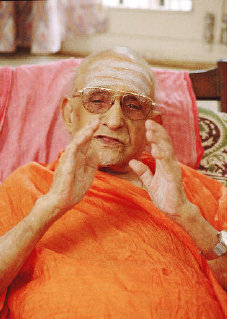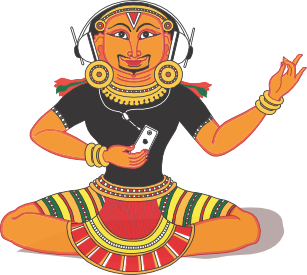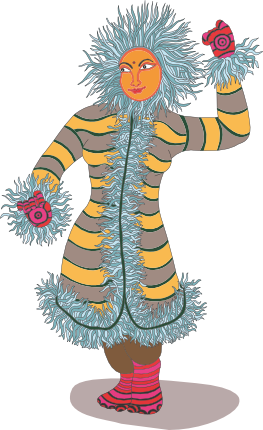‘Semmangudi’s music allows you to transcend’
An article by Meera Srinivasan (The Hindu, Sunday, Jul 27, 2008)
Paying tribute to the maestro on the occasion of his birth centenary, neuroscientist V.S. Ramachandran reflects on ‘the impulse that drives great music and art…the tremendous need, this desire to reach for the stars, to transcend your mortal frame.’

Semmangudi Srinivasa Iyer
CHENNAI: If there is something that fascinates physician and neuroscientist V.S. Ramachandran as much as phantoms in the brain, it must be Semmangudi Srinivasa Iyer’s music. His face lights up when he begins speaking about his favourite musician.
As a teenager, he went, with his mother, to one of the maestro’s concerts at the Mylapore Fine Arts Club and has been an ardent fan ever since. “His music has been a source of inspiration for the scientific, medical research I do,” says the Director of the Center for Brain and Cognition and Professor of Neurosciences and Psychology at the University of California, San Diego, and author of several acclaimed books about the human brain and mind. “Whenever I travel to give a lecture, I listen to a song by Semmangudi in my car. It elevates you to another plane and then the lecture goes off very smoothly. If you ask me why or what is going on in the brain, I still don’t know.”
From interactions with the great musician on different occasions, Dr. Ramachandran, who studied medicine at Stanley Medical College, Chennai and did a doctorate at Trinity College, Cambridge, recalls that Semmangudi’s perspectives exuded quintessential sarcasm, humour, and wit. “We spoke in Tamil and I’m afraid his humour will get lost in translation.” The neuroscientist, in the company of a few family members and friends, visited Semmangudi two years before he died in 2003. The maestro, who was born on July 25, 1908, was interested to learn that the neuroscientist was a grandson of Alladi Krishnaswamy Iyer (1883-1953) and they had a memorable chat:
Hindustani and Carnatic music

Dr. V.S. Ramachandran
Ramachandran: What is the difference between North Indian music and South Indian music?
Semmangudi: Look Rama, there is nothing like one being superior and the other being inferior. But North Indian music is like Krishnavatharam and ours, like Ramavatharam. Our music has purity. Their music is equally good but a lot of mischief creeps in, you see! We can sing in their style, but they cannot sing in ours. [The visitor requested the maestro to make available some of the audio recordings of his concerts. At that time, audio tapes were more popular than compact disks.]
Semmangudi: Rama, I do not believe in these tapes.
Ramachandran: Why do you say that, sir?
‘Flowers in a refrigerator’
Semmangudi: Look, it is like this. When we sing swarams, it is like decorating the raga devadai [angel] with flowers. It should come spontaneously, flowing freely like a pravaham [cascade]. If you stuff the swaras into a tape recorder, it will be equivalent to keeping the flowers in a refrigerator and taking them out periodically to smell their fragrance. Some people even take the tape recorder into the bathroom!
[Dr. Ramachandran’s annotation today is: “It is as if he is implying that respect should be accorded not only to him, but also to recordings of his music. You can’t be disrespectful by taking it to the bathroom. Of course, he was saying it in a humorous manner. Obviously it is not meant to be taken literally.”]
Ramachandran: I agree with your view on tape recorders, but I have heard your Thodi swarams for Sri Krishnam Bhaja Manasa and your Kapi raga alapana a hundred times and they retain the original freshness of the flowers.
Semmangudi: Oh Rama! That’s your bhakti, not my music! When we are singing swarams, it is like decorating the raga devadai with flowers. It shouldn’t seem like a spelling. It should be soaked in bhava.
[The neuroscientist’s annotation: “Today, many seem a little obsessed with calculations to show their virtuosity rather than bring out the bhava of the raga, which is what is unique to our music. And he’s absolutely right about that, isn’t he?”]
Ramachandran: What do you think about today’s musicians?
Contemporary musicians
Semmangudi: Oh, today’s musicians sing very well. People say [the quality of] music is declining but that is not true. All of them sing well, but they all sound just the same!
Ramachandran: How do you say that?
Semmangudi: Now we have the tape recorder, right? In those days we did not have tape recorders. My style is different, Madurai Mani’s style is different, MDR [M.D. Ramanathan]’s style is different. We were singing differently. But today people listen to each other’s music and start sounding similar. There are fewer opportunities for each artiste to evolve his own distinctive style.
Ramachandran’s friend: Sir, what do you think of other musicians?
Semmangudi: Who are you referring to?
Ramachandran’s friend: What is your opinion of Dr. Balamuralikrishna?
Semmangudi: Budhishaali! (He is extremely intelligent.)
Ramachandran’s friend: Oh, but he can’t sing like you, sir.
Semmangudi: Neither can I sing like him.
Favourite raga?
Ramachandran’s friend: Do you have a favourite raga?
Semmangudi: One cannot really say this or that is his favourite raga. Take Bhairavi, for instance. It is a boundless ocean. Each time you sing the ragam, the waves are different. What can we say about such an ocean? Take Thodi…it is another vast ocean.
Ramachandran: What do you think of MDR?
Semmangudi: He is a genius. You just have to listen to his Janani in Reethigowlai.
Ramachandran: What do you think of Mandolin Srinivas?
Semmangudi: He is a genius too.
Ramachandran: And M.S. [M.S. Subbulakshmi]?
MS ‘at the peak’
Semmangudi: Well, she is really at the peak. How can someone like me even begin to comment on her stature? I merely taught her a couple of songs…but she is at the very peak now.
Semmangudi [on the future of Carnatic music]: There is a misconception that the interest in Carnatic music is on the decline. In fact, there is a tremendous interest and passion among our youngsters all over the world for our great tradition in Carnatic music: It is immortal.
On one occasion, while introducing Maharajapuram Santhanam to the audience at a felicitation function at the Music Academy, the maestro said: “He is my guru’s [Maharajapuram Viswanatha Iyer’s] son. When he was a little boy, I would toss him up in the air and play with him, but now [sizing him up with his eyes], I can’t quite manage that.” The audience roared in laughter.
“Some people can humble you with their very presence,” remarks Dr. Ramachandran. “He was certainly one of them.”
Science and music
Gradually and cautiously, the research scientist in the passionate Semmangudi fan moves on to the question of how the brain could possibly produce music like his. “At this stage in our understanding of the brain,” reflects Dr. Ramachandran, “if we were to ask how the brain has these transcendental experiences, we are not anywhere near answering that question. If you ask a hard core scientist, he will tell you that there are neurons flaring away and some pattern of activity is producing a response to Semmangudi. So when I put on my scientist’s hat, I will tell you that there is some extraordinary pattern in his brain which is unique to him and him alone. On the other hand, sometimes, all you can do is throw up your arms in wonder and acknowledge that there is something transcendental which none of us understands and may be, will never understand. It is as if his music provides an antenna, a direct hotline to God. You feel transported.”
The ineffable quality of superior music is often inexplicable. “There is something about the music of Semmangudi or Madurai Mani. Madurai Mani’s swaram in Kanada, or Semmangudi’s neraval in Thodi are simply unmatched. Semmangudi’s swarams in the slower paces, medium paces were extraordinary. He was particularly good at that.”
Now, how does one explain, in neural terms, the experience of being transported?
The neuroscientist’s carefully considered answer is:
“People often ask me, reporters, journalists, students and colleagues — What is special about humans? After all, we are just a sophisticated ape, if you believe in Darwin’s theory of evolution, which obviously as a biologist I do.
“We have language, apes do not have language. You are aware of yourself. An ape doesn’t have that kind of awareness. We have laughter and humour, all of this is true. But in truth even the great apes have some rudiments of these abilities.
Transcendence
“One thing unique about being human, ironically, is the desire to be more than human. No ape wants to be more than an ape. So this tremendous need, this desire to reach for the stars, to transcend your mortal frame — that is the impulse that drives great music and art. That is what our music does, which western music doesn’t. It is more intellectual. This is common knowledge. But coming from a neuroscientist, it may have more credibility.”
So what is the connection between brain activity and transcendence? Nobody knows the answer, Dr. Ramachandran responds.
“As I say in my book The Emerging Mind, we are perpetually in this dilemma, that, on the one hand, everything we know from science tells you that you are merely a beast and, yet, you know in your heart you are much more than that.”
“Nobody really knows the answer to such questions. So you feel like you’re an angel trapped in the body of a beast, forever wanting to fly off, seeking transcendence. That is essentially the human predicament in a nutshell. And that is what music does every now and then. Semmangudi’s singing gives you a glimpse of the other world.”
Can science really attempt to explain artistic greatness of the Semmangudi kind? “Doesn’t matter what scientists say,” the neuroscientist answers. “Like my friend, a bookstore owner, once said: ‘You can take Semmangudi, put him in an MRI machine, and the report will come out saying ‘completely normal’!”
Artistry, I persist, cannot be explained by science. But does science acknowledge that different faculties of the brain manifest themselves in different aspects of music?
“Undoubtedly, yes,” exclaims Dr. Ramachandran. “There is clearly something going on in the brain. But it may not merely be that. I adopt a point of view which is called being a Platonist in philosophy, which is very unfashionable because modern philosophers are realists. They believe that there are atoms and molecules, and everything else follows. The fallacy here is to argue that because you have explained something, you have explained it away. Contrary to this view, Plato insisted that there are other realms of reality. Each realm has its own laws and acquires its own beauty once it has emerged.
“You might say it has now acquired its own dimension of reality,” the neuroscientist adds. “And if you go even further beyond that, you get transcendence, which few musicians achieve. Just like Einstein came up with the theory of relativity…Semmangudi’s music allows you to transcend. Take his Sri Krishnam Bhaja Manasa or his Ragam Thanam Pallavi in Shanmugapriya, for instance. There is a certain grandeur about his music — it is majestic and extrovert —touching the very ‘hem of divinity’.”
Recalling his meeting with the maestro, Dr. Ramachandran says: “As soon as we walked in, we saw a photograph of Ariyakudi on the wall. I didn’t ask him anything about it and he didn’t say anything either. I remember that [Francis] Crick similarly had only Einstein’s picture on his wall. It sort of implies, ‘This is the only other person whose existence I acknowledge’.”






